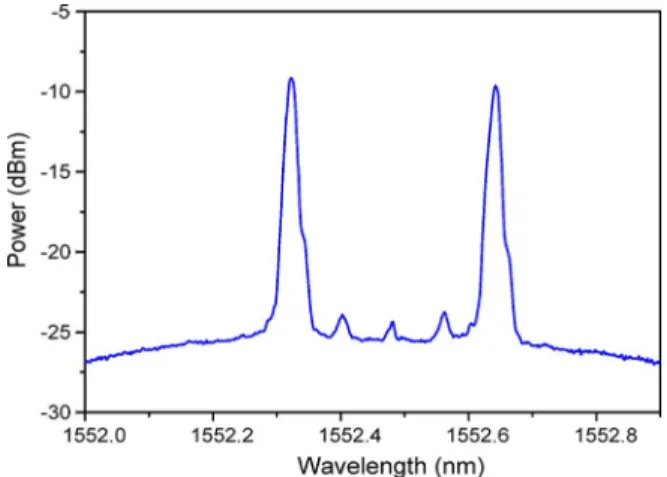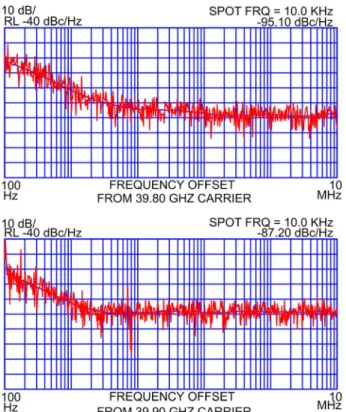IEEE PHOTONICS TECHNOLOGY LETTERS, VOL. 21, NO. 4, FEBRUARY 15, 2009 209
Optical mm-Wave Signal Generation by Frequency
Quadrupling Using an Optical Modulator and a
Silicon Microresonator Filter
Lin Xu, Chao Li, C. W. Chow, and Hon Ki Tsang
Abstract—By adjusting the direct current (dc) bias on an electrooptic modulator to suppress the first-order sideband and subsequently using a double-waveguide micro-ring resonator to filter out the optical carrier, millimeter (mm)-wave signal was generated at a frequency of four times the 10-GHz local oscillator. A monolithic integrated silicon-based optical mm-wave signal gen-erator by frequency quadrupling is proposed. A silicon integrated microresonator filter was fabricated and its design parameters are given. High extinction ratio optical mm-wave signal was obtained. The single sideband noise spectrum of the generated 40-GHz optical signal was measured, showing similar performance when compared with that generated by a radio-frequency synthesizer.
Index Terms—Frequency quadrupling, microring resonator, millimeter (mm)-wave.
I. INTRODUCTION
H
IGH data rate wireless transmission instead of installing new fiber to connect individual buildings in metropolitan areas may help to reduce cost for future deployment of broad-band networks in metropolitan areas. Existing standards such as the IEEE 802.16 need high-frequency carrier signals in the 10- to 66-GHz spectral ranges. The microwave signals may be distributed by conventional optical fiber to the antenna base stations, thus consolidating the carrier frequency generation and data modulation at the head-end station and reducing the cost and complexity of the antenna sites. The radio-over-fiber (ROF) technique is attracting much attention in the broadband wire-less access networks, in which optical millimeter (mm)-wave generation is a key technique [1]. The approach of using a single laser source and an external optical modulator is based on the inherent response of the optical modulator for generatingManuscript received September 07, 2008; revised November 10, 2008. First published December 09, 2008; current version published January 28, 2009. This work was supported in part by Research Grants Council grant 415905 and in part by CUHK Research Committee funding (project 3110032). The work of C. W. Chow was supported by the National Science Council, Taiwan, NSC 96-2218-E-009-025-MY2 and NSC 97-2221-E-009-038-MY3.
L. Xu, C. Li, and H. K. Tsang are with the Department of Electronic En-gineering, The Chinese University of Hong Kong, Shatin, Hong Kong, China (e-mail: lxu@ee.cuhk.edu.hk; cli@ee.cuhk.edu.hk; hktsang@ee.cuhk.edu.hk).
C. W. Chow is with the Department of Photonics, Institute of Electro-Optical Engineering, National Chiao Tung University, Hsinchu 30010, Taiwan (e-mail: cwchow@faculty.nctu.edu.tw).
Color versions of one or more of the figures in this letter are available online at http://ieeexplore.ieee.org.
Digital Object Identifier 10.1109/LPT.2008.2010056
high-order optical sidebands and has shown good potential for producing high-purity, high-frequency mm-wave signals. In [2]–[5], there have been several reports on ROF system that reduce the complexity and cost of the system. However, the local oscillator (LO) frequency is only double to produce the optical mm-wave carrier. To overcome the limitation and to produce higher frequency, an optical generation scheme that uses narrow bandwidth optical components to generate high-frequency electrical signals becomes attractive. An optical mm-wave generation scheme has proposed in [6] by multiple frequency doubling technique through properly adjusting dc bias on external modulator to further reduce the LO frequency and bandwidth of the external modulator.
In this letter, we propose and demonstrate a technique for optical mm-wave signal generation by frequency quadrupling. By setting the dc bias of a Mach–Zehnder electrooptic modu-lator (MZM) to its transmission maximum, second-order side-bands are generated while the first-order sideside-bands can be sup-pressed. Besides the two peaks of the second-order sidebands, the output of the MZM also contains the input carrier frequency component. A high performance optical filter (a microresonator notch filter) is used to remove the optical carrier, so that the two second-order sidebands can then be beat together in a pho-todetector at the antenna site in the ROF system to generate the mm-wave that has a frequency equal to four times the LO frequency. High extinction ratio optical mm-wave signal is ob-tained. The single sideband (SSB) noise spectrum of the gener-ated 40-GHz optical signal is measured, showing similar perfor-mance when compared with that generated by a radio-frequency (RF) synthesizer.
II. FABRICATION OF THEMICRORESONATOR
The microring resonator was fabricated at IMEC (http:// www.imec.be) Belgium on a silicon-on-insulator wafer with a 0.22- m-thick top silicon layer and a 2- m-thick buried oxide layer, as shown in Fig. 1(a) and (b). The waveguides were 500 nm wide and the device layout was defined by 193-nm-deep ultraviolet photolithography, and transferred onto the device layer by dry etching. The entire device was clad with a 0.75- m-thick high-density plasma oxide. Light was coupled into and out of the microring resonator via a tapered waveguide grating coupler [7]. The loaded quality factor ( ) for the resonance is 4000, as shown in Fig. 1(c). The racetrack microring arc radius is 8 m, and the straight interaction length
210 IEEE PHOTONICS TECHNOLOGY LETTERS, VOL. 21, NO. 4, FEBRUARY 15, 2009
Fig. 1. (a) Top-view scanning electron micrograph (SEM) of the fabricated waveguide coupled microring resonator. I: Input port; T: Throughput port; D: Drop port. (b) Cross-section schematics of the waveguide. (c) Measured transverse-electric-polarized throughput and drop port spectra.
Fig. 2. Proposed silicon-based optical mm-wave signal generator by frequency quadrupling. TL: tunable laser; PC: polarization controller; VOA: variable op-tical attenuator; I: input port; T: through port; D: drop port.
is 6 m. The fabricated air-gap spacing between the ring and the waveguide is about 200 nm.
III. EXPERIMENT, DISCUSSION,ANDRESULTS
Fig. 2 shows the proposed silicon-based optical mm-wave signal generator by frequency quadrupling. A continuous-wave light at the wavelength of 1552.46 nm generated by a tunable laser (HP 8168F) was tuned exactly to the resonance wavelength of the microring filter. A commercially available MZM was used in the proof-of-principle demonstration. For future work, the microring filter could be monolithic integrated with the previ-ously proposed silicon-based optical modulator [8] to achieve the mm-wave signal generator by frequency quadrupling. It was applied by a 10-GHz sine wave RF signal generated by a synthe-sizer at about 1.3 V . In order to produce the optical two-tone for optical mm-wave generation, the dc bias of the MZM can be set in two states. When the dc bias is set to a minimum trans-mission, double-sideband suppressed carrier optical modulation can be achieved, where the output of the MZM has the first-order sidebands, and in principle, without the carrier frequency. The frequency separation between the two sidebands is equal to two times the modulating signal frequency. Hence this only pro-duces frequency doubling. In order to achieve frequency qua-drupling, the dc bias can be set to a transmission maximum. In this case, second-order sidebands can be generated, and the fre-quency separation between the two second-order sidebands is equal to four times the modulating signal frequency. An optical
Fig. 3. Optical spectrum at the second-order optical sidebands at the output of the microresonator.
Fig. 4. RF spectrum of the generated 39.8-GHz signals.
notch filter is needed to remove the carrier frequency. In the ex-periment, the optical signal generated at the output of the MZM was then coupled into the microring resonator through the input port (I). The total input and output coupling loss from fiber to the microring filter was measured to be 9 dB. The optical carrier was removed by the notch filter characteristics of the microring res-onator when measured at the drop port (D). The power coupling ratio from the waveguide to the microring was 12.4% (versus a design targeted value of 12%). For the double waveguide mi-croring resonator, there is a critical coupling only if the ring is lossless. However, the extinction ratio of the notch filter used in this experiment was 30 dB, which is close to critical coupling. The signal was then measured by an optical spectrum analyzer (OSA) and an analyzer, consisting of a 40-GHz PIN photode-tector and an RF spectrum analyzer.
Fig. 3 shows the optical carrier and the first-order sidebands are 15 dB lower than that of the second-order sidebands. The optical spectrum was measured by an OSA with a resolution of 0.01 nm. The wavelength spacing between the two second-order modes was 0.318 nm (equal to 40 GHz). A mm-wave signal that has four times the frequency of the microwave drive signal was thus generated by beating the two second-order optical side-bands at a photodetector, which could be located at the antenna
XU et al.: OPTICAL mm-WAVE SIGNAL GENERATION BY FREQUENCY QUADRUPLING 211
Fig. 5. Top: SSB noise spectrum of the RF frequency synthesizer measured at 40-GHz tone. Bottom: SSB noise spectrum of the proposed scheme measured at 40-GHz tone.
site in the ROF system. Including the 9-dB coupling loss (which may be reduced by integrating the filter with modulator), there was a measured 18-dB loss in average RF power using this method of frequency quadrupling.
Fig. 4 shows the RF spectrum of the 40-GHz optical mm-wave signal measured by a 40-GHz PIN photodetector and HP8564E spectrum analyzer (with resolution of 10 MHz). In Fig. 4, the frequency harmonic components (10, 20, and 30 GHz) also appear in the trace while the 40-GHz harmonic component is about 20 dB higher than the other frequency components.
Fig. 5 (bottom) shows the SSB noise spectrum of the gener-ated 40-GHz optical mm-wave. The SSB noise spectrum of the 40-GHz signal generated by an RF frequency synthesizer (Ag-ilent E8244A) shown in Fig. 5 (top) is also given for
compar-ison. We observed that the SSB noise of the proposed scheme shows similar performance when compared with that of a com-mercially available frequency synthesizer. The noise increases from 87.20 to 95.10 dBc/Hz of the proposed scheme at a spot frequency of 10.0-kHz offset.
IV. CONCLUSION
We demonstrated a simple technique for frequency quadru-pling using an MZM and a microring resonator. A 40-GHz op-tical mm-wave signal was generated from a 10-GHz signal using this technique. The technique relied on the inherent modulation response of an MZM when it is biased at transmission maximum to suppress the odd order optical sidebands, and optical notch filter characteristics of a microring resonator to remove the op-tical carrier. The scheme has the potential for silicon integration and thus allows a lower frequency device such as RF source and optical modulator to generate high-frequency optical mm-wave signals, which significantly reduce the cost of the dense wave-length-division-multiplexing ROF system.
REFERENCES
[1] Z. Jia, J. Yu, G. Ellinas, and G.-K. Chang, “Key enabling technolo-gies for optical-wireless networks: Optical millimeter-wave generation wavelength reuse, and architecture,” J. Lightw. Technol., vol. 25, no. 11, pp. 3452–3471, Nov. 2007.
[2] M. Attygalle, C. Lim, and A. Nirmalathas, “Extending optical trans-mission distance in fiber wireless links using passive filtering in con-junction with optimized modulation,” J. Lightw. Technol., vol. 24, no. 4, pp. 1703–1709, Apr. 2006.
[3] T. Kuri and K. Kitayama, “Optical heterodyne detection technique for densely multiplexed millimeter-wave-band radio-on-fiber systems,”
IEEE Photon. Technol. Lett., vol. 21, no. 12, pp. 3167–3169, Dec.
2003.
[4] X. Zhang, B. Liu, J. Yao, K. Wu, and R. Kashap, “A novel mil-limeter-wave-band radio-over-fiber system with dense wavelength-di-vision multiplexing bus architecture,” IEEE Trans. Microw. Theory
Tech., vol. 54, no. 2, pp. 929–937, Feb. 2006.
[5] L. Chen, X. Y. Lei, S. C. Wen, and J. G. Yu, “A novel radio over fiber system with DWDM mm-wave generation and wavelength reuse for upstream data connection,” Opt. Express, vol. 15, no. 9, pp. 5893–5897, 2007.
[6] G. H. Qi, J. P. Yao, J. Seregelyi, S. Paquet, and C. Belisle, “Generation and distribution of a wide-band continuously tunable millimeter-wave signal with an optical external modulation technique,” IEEE Trans.
Mi-crow. Theory Tech., vol. 53, no. 10, pp. 3090–3097, Oct. 2005.
[7] D. Taillaert, P. Bienstman, and R. Baets, “Compact efficient broadband grating coupler for silicon-on-insulator waveguides,” Opt. Lett., vol. 29, no. 23, pp. 2749–2751, 2004.
[8] L. Liao, D. Samara-Rubio, M. Morse, A. Liu, D. Hodge, D. Rubin, U. Keil, and T. Franck, “High speed silicon Mach–Zehnder modulator,”

